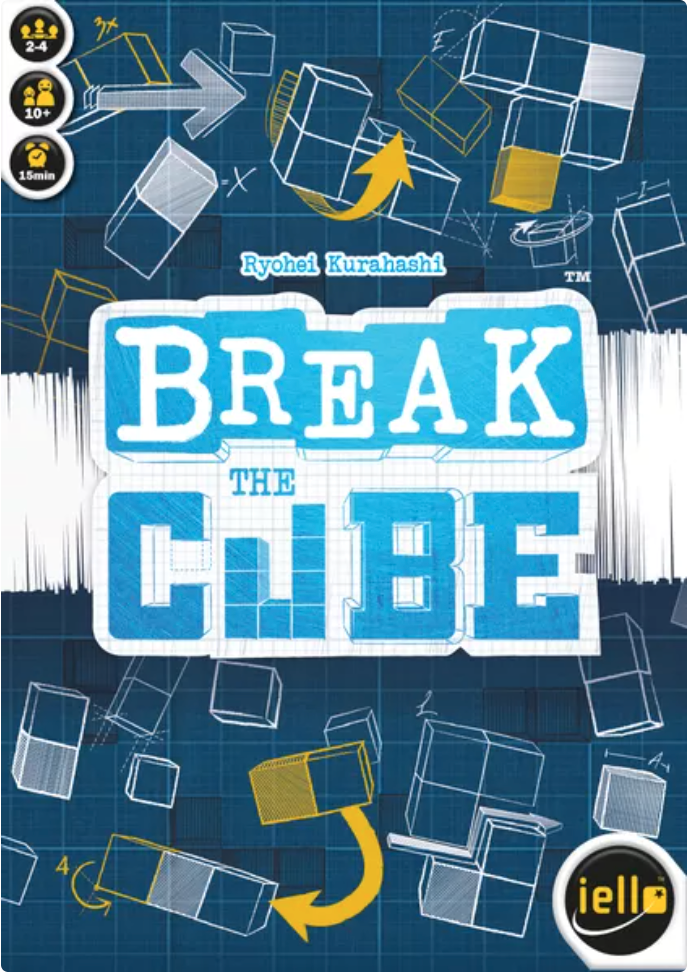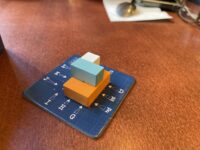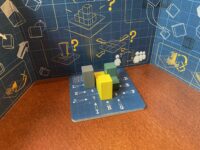- Learning time
- 5 minutes
- First play time
- 40 minutes
Break the Cube
Designed by: Ryohei Kurahashi
A new, less mathy version of Break the Code, Break the Cube gives the same logical deduction challenge, but with physical properties to handle rather than abstract concepts in your head.
The original asks players to deduce a hidden 4-number code. Break the Cube demands you figure out your neighbour’s arrangement of geometric pieces on a numbered grid. Everyone takes three wooden pieces (large, medium, small) and sets them up behind their screen in whatever manner they choose, as long as everything is on the grid, with no overhangs, and no ‘levels’ stacked more than three blocks high.
You have another grid too, which we’ll call grid B, and pieces matching your neighbour’s. Whilst the player to your left is trying to work out where you’ve placed your blocks, your goal is to work out what the player to your right has done. On your turn you do one of three things: you can ask what your opponent sees when they look down at one of the nine numbered squares (you’ll learn the colour, but not the height) or you can ask what they see when they look along one of the grid’s lettered corridors (where you’ll learn the colours and height, but not the precise location in terms of distance). The catch with the latter option is that you too, must reveal the same information to the table, which will be of great interest to the player on your left!
Finally, you can make a guess, arranging the blocks on grid B in a way you hope matches the player’s on your right. If you’re wrong, play continues. If you’re correct, the end-game is triggered with anyone who’s had one less turn than you getting a last chance to guess correctly as well.
The guru's verdict
-
Take That!
Take That!
None really. Players are engaged in a series of overlapping puzzles, so the interaction is indirect.
-
Fidget Factor!
Fidget Factor!
Depends on the player count. It's not a game that moves at a rat-a-tat pace, as everyone will be engaged in their own version of a logic puzzle. So it's reasonably fast with two, but can be a little longer with four.
-
Brain Burn!
Brain Burn!
You may find the notepads (supplied) helpful! Essentially though it's about eliminating possibilities, and keeping track of what remains, like Sherlock Holmes trapped in a game of Tetris.
-
Again Again!
Again Again!
If you enjoy Break the Code's deductional charms, then each play is a poser, and you can even add complexity by hiding four pieces instead of three for a greater challenge.









Sam says
I prefer this to the earlier Break the Code, which I respected as a design without finding it quite as gripping as the people I played with did. I'm not a particularly numerate person beyond basic addition, so this more visual, tactile and basically less numbersy approach feels instantly more engaging: being able to move the physical props around to try new potential solutions, for me, is just much more fun than juggling abstract concepts in my head. I think it'll work better for kids, too, and I love the fact you can ramp up the difficulty with adding in more pieces. It's an abstract puzzle of furrowed brows, and not a narrative-driven game of luck and laughter (which is more my default) but I still like Break the Cube - a lot.